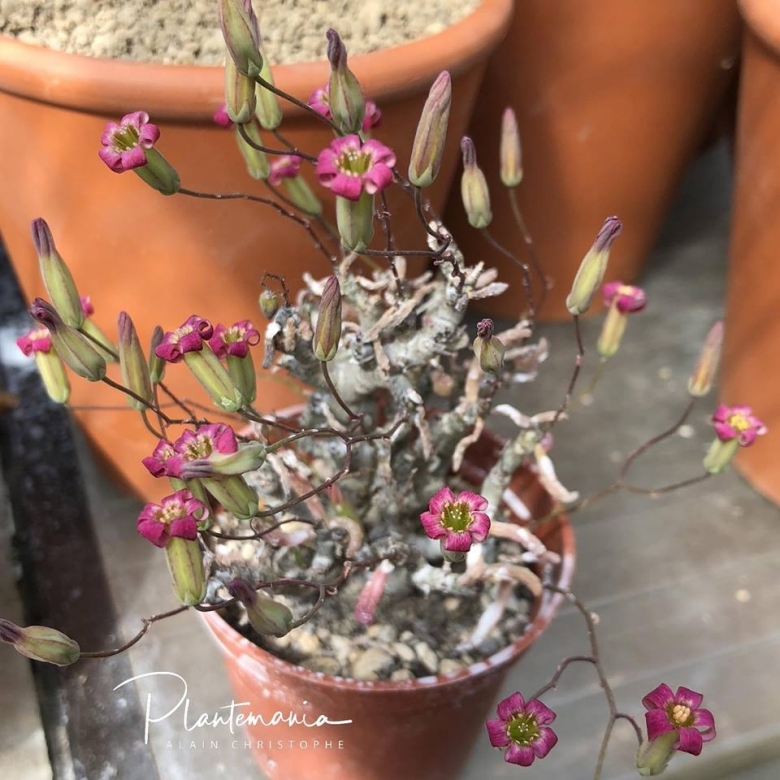Accepted Scientific Name: Tylecodon schaeferianus (Dinter) Toelken
Bothalia 12: 380 1978.

Adromischus schaeferianus (Tylecodon schaeferianus) Photo by: © Plantemania
Origin and Habitat: Tylecodon schaeferianusSN|35272]]SN|35272]] is recorded from the coastal strip from Luderitz Bay in south-western Namibia to just south of the Orange River mouth in the north-western Cape Province (Richtersveld Coastal Duneveld, Western Gariep Plains Desert, Western Gariep Lowland Desert), in the Republic of South Africa.
Type locality: Namibia, Luderitz Bay
Habitat and ecology: This species grows on sandy or gravelly flats, often in exposed positions or in rocky crevices on shaded, south-facing among lichens. Flowering period: Late winter-spring (September, October). This species occurs on shales associated with diamond bearing gravel, and as a result, most of its habitat around Alexander Bay has been destroyed through mining or prospecting activities. Subpopulations are small, this species occurs in isolated clumps of a few plants, separated by large distances.
Synonyms:
See all synonyms of Tylecodon schaeferianus
back
Accepted name in llifle Database:Tylecodon schaeferianus (Dinter) ToelkenBothalia 12: 380 1978.Synonymy: 11
back
Common Names include:
AFRIKAANS (Afrikaans): Sandnenta
Description: Tylecodon schaeferianusSN|35309]]SN|35272]] is a branched perennial succulent, often forming tufted mounds with very short gnarled, interwoven stems (rarely extensively branched) with light coloured, fissured bark and small egg-shaped green leaves. The plant has a branched underground tuberous rootstock (caudex) to 10 cm in diameter and 7 cm tall which qualifies it to be a caudiciform. It has lavender to pink flowers in winter.
Root: Tuberous to 1 cm in diameter, grey, with flaking bark.
Branches: One to several smooth, spreading to ascending, (5-)20-40(-150) mm long, 2-5 mm thick, sometimes with aerial roots. Bark knobbly, flaking from the irregular phyllopodia, irregularly pale grey-brown.
Leaves: Obovate, elliptic to orbicular, (5-)8-15(-20) x (3-)6-12(-16) mm, thick and slightly dorsiventrally compressed and often slightly grooved above main vein, base cuneate, apex acute, obtuse or truncate, with reddish mucro, with a few hairs when young, glabrous later, green to pale brown with red striations.
Inforesceces. Thyrses to 2.5 cm with 1-2 monochasia, each bearing 1-2 erect lowers (rarely in cultivation more). Peduncle 15-40(-60) mm long, purplish brown. Pedicels 4-12 mm long.
Flowers: Glabrous rarely with a few papillae.Calyx 2-3,5 mm long, with a few club-shaped hairs or glabrous, green, calyx-lobes triangular-lanceolate, acute. Corolla tubular to funnel-shaped, 7-10 long, 4 mm in diameter, glabrous, pink or white, inside with a few fine hairs where filaments are fused to tube, yellowish green. Corolla-lobes spreading to recurved, 3-6 mm long recurved, violet, pink or rarely white. Anthers 0,9-1,2 mm long. Squamae oblong, 0,9-1,1 mm long, 0,2-0,3 mm broad, usually more or less notched, slightly fleshy, pale yellowish green.
Taxonomy notes: Dinter described two species, and although he did not initially distinguish them clearly, he later apparently separated Cotyledon hoerleinianaSN|35274]]SN|35281]] by its erect branches and Cotyledon schaeferianaSN|35281]]SN|35274]] by its very short branches, but all intermediates are found in habitat. In cultivation small plants ultimately develop long stems. Tylecodon schaeferianusSN|35272]]SN|35272]] can produce dense mats like those of Tylecodon decipiensSN|35272]]SN|35309]], but is distinguished by its thinner stems and glabrous flowers.
 Adromischus schaeferianus (Tylecodon schaeferianus) Photo by: Diego Armentano
Adromischus schaeferianus (Tylecodon schaeferianus) Photo by: Diego ArmentanoSend a photo of this plant.The gallery now contains thousands of pictures, however it is possible to do even more. We are, of course, seeking photos of species not yet shown in the gallery but not only that, we are also looking for better pictures than those already present.
Read More... Cultivation and Propagation: Major references and further lectures
1) Urs Eggli “Illustrated Handbook of Succulent Plants: Crassulaceae” Springer Science & Business Media, 06 December 2012
2) Dr J.P. Roux “Flora of South Africa” 2003
3) Doreen Court “Succulent Flora of Southern Africa” CRC Press, 01 June 2000
4) Ernst Van Jaarsveld, Ben-Erik Van Wyk, Gideon Smith, “Succulents of South Africa: A Guide to the Regional Diversity” Tafelberg, 2000
5) von Staden, L. & Van Wyk, P.C.V. 2015. Tylecodon schaeferianusSN|35272]]SN|35272]] (Dinter) Toelken. National Assessment: Red List of South African Plants version 2017.1. Accessed on 2018/06/30
6) Hall, A.V., De Winter, M., De Winter, B. and Van Oosterhout, S.A.M. 1980. “Threatened plants of southern Africa.” South African National Scienctific Programmes Report 45. CSIR, Pretoria.
7) Hilton-Taylor, C. 1996. “Red data list of southern African plants”. Strelitzia 4. South African National Botanical Institute, Pretoria.
8) Raimondo, D., von Staden, L., Foden, W., Victor, J.E., Helme, N.A., Turner, R.C., Kamundi, D.A. and Manyama, P.A. 2009. “Red List of South African Plants”. Strelitzia 25. South African National Biodiversity Institute, Pretoria.
9) Snijman, D.A. 2013. “Plants of the Greater Cape Floristic Region 2: The extra Cape flora”. Strelitzia 30. South African National Biodiversity Institute, Pretoria.
10) Tölken, H.R. 1978. “New taxa and new combinations in Cotyledon and allied genera.” Bothalia 12(3):377-393.
11) Tölken, H.R. 1985. Crassulaceae. In: O.A. Leistner (ed). “Flora of southern Africa” 14,1:1-244. Botanical Research Institute, Pretoria.
12) Van Jaarsveld, E.J. and Koutnik, D. 2004. “Cotyledon and Tylecodon”. Umdaus Press, Pretoria.











